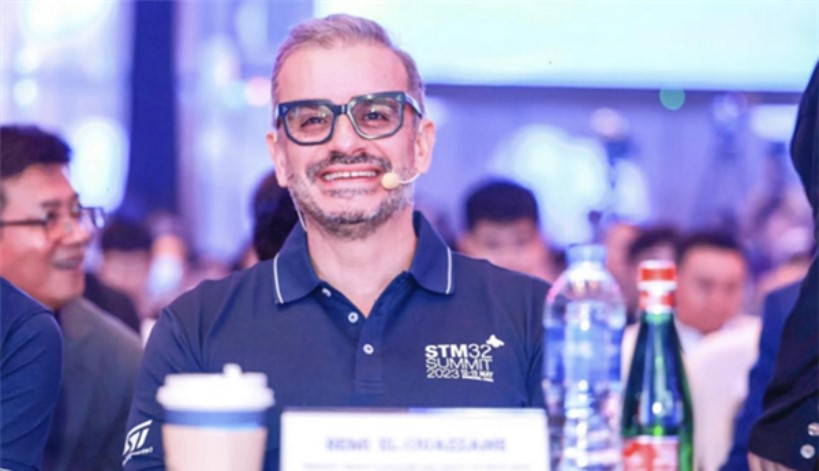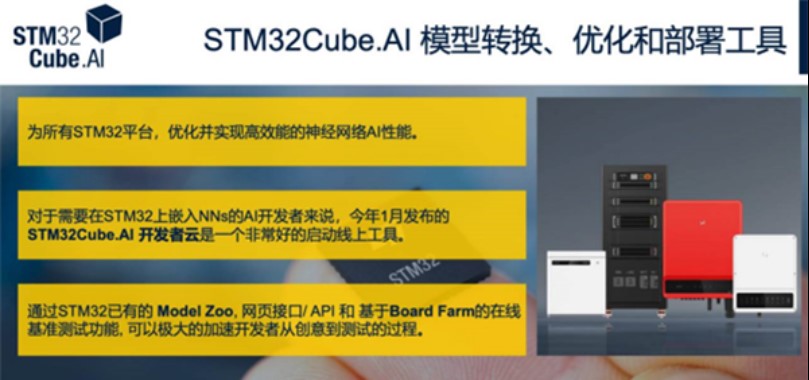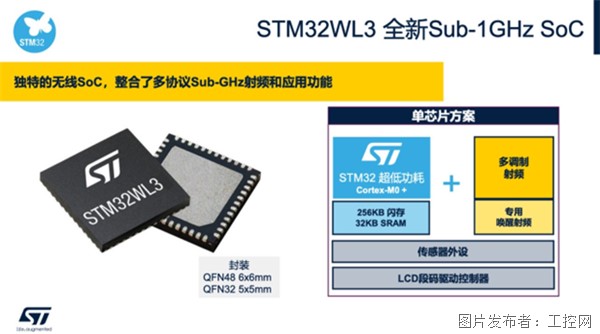Since the release of STM32F1, the first chip of STM32 family in 2007, ST has started a legendary journey in the field of general MCU. From 1 billion in 2013, 6 billion in 2020 to 11 billion now, the sales volume of STM32 are rising faster and faster. The reason its success is each generation products perfectly meets the current industry needs, and in the process of several iterations of products, the consistent development environment continues, and with the accumulation all the way, the whole STM32 ecology becomes more and more prosperous.
In 2023, the universal MCU is no longer simply employ, and several large sub-tracks have enough quantity to support the differentiated development of its universal MCU. what kind of MCU is the future industry application trend? What kind of MCU can meet the needs of future application development? How to build a living MCU ecology with diversity and growth? We all found answers to these questions at the STM32 Summit in 2023.
AI is deployed at the edge
For the later MCU, the most important application trend comes from the sinking deployment of AI at the edge. How to deploy AI algorithm on MCU and MPU with smaller resources in terms of energy consumption requirements at the edge? This requires stronger software and hardware integration capability on the end side, and can simplify the deployment of AI algorithm, so that MCU application engineers without AI algorithm experience can easily get started. As far as ST is concerned, the combination of AI and MCU has been explored since 2017. STM32N6, the industry's first MCU integrated with NPU, which was pre-released at this summit, will be an important product direction for the layout of edge AI.
"STM32N6" MPU Level AI Performance, MCU Level Power Consumption and Cost
It is reported that STM32N6 adopts Arm Cortex-M55 kernel, which integrates ISP and NPU internally, and can provide excellent machine vision processing capability and AI algorithm deployment. The NPU unit is not the NPU core of U55 when Arm released M55, but the NPU IP--Neural-Art accelerator developed by ST itself. This is conducive to reducing the licensing cost and improving the product price competitiveness of the final client; At the same time, ST can independently control the rhythm of iterative upgrade on this NPU IP.

STM 32N6
Remi El-Ouazzane, president of microcontroller and digital IC products department (MDG) in STMICROELECTRONICS, said that for STM32N6, the reason why STM32N6 was not released like the usual STM32 is also because it is a very novel MCU. In fact, it is also the first MCU to integrate ISP and neural processing unit. ST already has a roadmap for the Neural-Art accelerator inside, which will also be based on ST's internal processors and evolving digital processors. ST already has a clear and complete roadmap for the next 5 years.

Remi EI-Ouazzane, President of Microcontroller and Digital IC Products Division (MDG), STMICROELECTRONICS
According to Ricardo De-Sa-Earp, Executive Vice President of STMICROELECTRONICS and General Manager of General Microcontroller Sub-products Department, ST has started to provide STM32N6 samples to some potential customers since September last year, and will continue to expand the scope of sample provision in the second half of this year. After STM32N6, the Neural-ART accelerator will be specially equipped on STM32MP2 in the future. Edge artificial intelligence will be very important in the development of the whole industry.
"Cube.AI" edge AI, the software side is the key
For the combination of MCU and AI, compared with the previous general MCU, the value of software becomes greater. Cube.MX makes the development of STM32 more efficient and convenient. For the development and deployment of edge AI, Cube.AI is of greater significance to MCU application engineers. It can break through the barrier between AI algorithm and MCU application, and enrich the actual AI edge application.
"AI is never only concerned with hardware products. Artificial intelligence pays more attention to the software, and the software is the key." Remi shared that.
Through Cube.AI, developers can build models according to their own needs, highly optimize the deep neural network model created by standard AI tools, and optimize it to C code suitable for MCU resource level, so that developers' edge AI algorithm can finally be executed. In addition, developers can use the ST low code tool NanoEdge AI Studio to get the blessing of related data science solutions. Therefore, edge AI applications can be directly constructed without steep AI skills and data set learning curves.

STM32Cube. Tool for AI module transfer, optimize and deploy
At the beginning of this year, ST also released the first MCU AI developer platform in the cloud-STM32Cube. AI developer cloud to help developers further accelerate the edge AI development process. According to Ricardo, on this platform, developers can learn how to develop neural network MCU in specific applications. The cloud template library will be updated at least 4 times a year, while the board library will be updated in real time according to product updates; Developers can compare and select AI templates that are most suitable for their MCU models on this platform.
The optimized algorithm is deployed on the end side, will the accuracy be greatly reduced? This should be a point of great concern to developers. According to NVIDIA's demonstration at the summit, this will not be a problem after optimize. According to the case shared by Luis WU of NVIDIA Deep Learning Technology Manager at the summit, the personnel detection model trained by NVDIA TAO 5.0 can be directly deployed on STM32H747, but the memory occupation and update rate are low. After cutting and quantifying the model by STM32 Cube. AI, the accuracy is only reduced by 0.5%, but the memory occupancy is reduced several times, and the update rate is directly increased from 1.3 FPS to 9FPS, and the optimization effect is very obvious.
Secure wireless connection
In addition to edge AI, secure wireless connection is another important direction of general MCU, and secure wireless connection will become another key driving force to support the rapid growth of general MCU besides AI. According to the data from ABI Research, the target market of wireless STM32 will increase from 5.1 billion US dollars in 2020 to 11.2 billion US dollars in 2027. Since STM32WB in 2018, ST developers have provided wireless MCU products with different protocols, and provided complete ecological support. At this year's STM32 Summit in 2023, ST brought two new wireless MCU products. They are focus on Bluetooth and low-power long-distance transmission scenarios respectively.
"STM32WBA" Bluetooth MCU with higher performance and more secure
STM32WBA is ST's brand-new Bluetooth wireless MCU product. Compared with the previous STM32WB, the first one adopts the brand-new STM32U5 platform after the biggest upgrade, and STM32U5 platform is ST's first product adopting Cortex-M33 core. Based on this new core, STM32WBA has a better foundation in power consumption, performance and security, and the main frequency of the core reaches 100MHz. In terms of memory, it provides up to 1MB flash memory/128KB RAM, thus ensuring that developers can realize more complex program running.
The chip supports the latest Bluetooth low power 5.3 protocol, and integrates balun and matching circuits internally, which helps reduce the peripheral components of wireless design. The output power exceeds + 10dBm, which improves the RF performance by 60% compared with other competing products. In terms of security, STM32WBA is based on arm trust zone and ST's own patented security technology, achieving the highest level of SESIP and PSA L3 certification goals.

Comparison between STM32WBA and other plans
In addition to the above highlights, "flexibility of software protocol adaptation", "scalability" and "portability" are another feature of STM32WBA. Like Matter protocol, which is expected to unify the interconnection of different brands in smart home, STM32WBA can also be satisfied. For customers who are currently using the older generation of STM32L4 products, CubeMX can realize efficient migration and transmission of old codes and data, thus obtaining additional wireless function support; And it can be further enhanced with the help of STM32Cube. AI.
"STM32WL3" New Sub-1GHz SoC
In terms of LPWAN, ST brought an updated product model STM32WL3. The product adopts a single chip, and two RF units and a Cortex-M0 + core are integrated on one chip; At the same time, it also has LCD controllers, sensors and other rich peripherals.

STM32WL3 new Sub-1GHz Soc
It is clear to see that STM32WL3 is actually very suitable for the application of smart meters. Sensor peripherals can be connected with sensor signals such as water, electricity, gas and heat, LCD is used to display data, and radio frequency unit is used to transmit meter data. The multi-modulation radio frequency unit of STM32WL3 can support various protocols such as Sigfox, W-BUS, Mioty and Wi-Sun. The dedicated wake-up radio frequency unit consumes only 4.2 A in the receiving mode, which can ensure that the MCU core is in a low power consumption state for more time and only wakes up when receiving data packets.
In addition to the wireless MCU mentioned above, ST will also update two product models for industrial high-speed connection scenarios, namely ST60 which directly tells contactless connection and STM32MP1 which supports EtherCAT. The ST60 is internally integrated with a complete 60GHz RF transceiver, which can replace the board-to-board connection cable. Based on STM32MP1, ST's partner Acontis provides Linux-RT + EtherCAT main stack solutions for a wide range of industrial customers.
To the future product planning, Ricardo said that the wireless MCU of ST will continue to further improve the memory, optimize the size and improve the flexibility of the application side in the future.

According to Ricardo De-Sa-Earp, executive vice president of STMICROELECTRONICS and general manager of general microcontroller sub-products department
Omni-directional security scheme
Currently, safety have become the last topic to catch up with in the internet of things industry, and users and equipment manufacturers pay more and more attention to safety. With more complex wireless connection scenarios, more types of terminal forms and more powerful quantum attacks, the construction of security becomes more complicated. The construction of security is not only a matter of software, but also needs to realize safe isolation on the underlying hardware.
For security, ST provides many hardware IP and corresponding encryption algorithms, including some encryption technologies of information itself. Products such as STM32WBA and STM32MP1 have achieved self-high security target certification of PSA Level 3 and SESIP Level 3, which improves a good security foundation for customers' applications from the underlying hardware aspect.

Security is not only at the hardware level, but also at the software level. In order to facilitate the development of users' security functions, ST has specially launched a security toolbox-Security Manager. By this tool, users can choose the necessary security function modules independently according to their actual scenarios and application requirements, and the construction of embedded security solutions for users will become simpler and more reliable.
"Not only from the single device level, ST can have strong security guarantee, but through security units like STSAFE, we can also ensure that every generation of products has security functions." Julian, Vice President of Microcontroller and Digital IC Products Department of STMICROELECTRONICS Asia Pacific, Internet of Things/Artificial Intelligence Technology Innovation Center and Digital Marketing, added, "At the same time, from the network part, we also have STM32MP1, which can ensure the security of multiple devices entering the same network from the network perspective."
Ecological value: more than the core
"The cooperation between ecosystem and ecosystem partners has always been a very important part of STM32 product positioning." Julian stressed, "We believe that only by integrating more partners with the same values can we achieve common innovation." The continuous success of STM32 for more than ten years cannot be separated from its ecological growth and prosperity. The strength from various partners in the ecology helps the participants in the ecology to find more STM32 use cases, and can always feed backed the demand from the market to the product research and development end of ST at the first time, helping them to formulate the next generation product roadmap more clearly and accurately.
The theme of this summit is "More than Silicon" and "More than Core", which means that ST provides more software value besides its own MCU products. Cao Jindong, director of Microcontroller and Digital IC Products Department (MDG) in STMICROELECTRONICS China, said that with the increasing performance of MCU and the increasing complexity of customers' applications, ST not only needs to provide support for MCU performance, but also needs software to help customers carry out practical innovative applications. Over the years, ST has continuously invested in development in two directions to provide customers with soft value, firstly, embedded development software based on PC to facilitate engineers and customers to develop more quickly; Secondly, embedded software, including some mobile protocol stacks, such as USB protocol stack, graphics (image display), low power communication and so on. Through the iteration of ST software, developers can be further helped to iterate and upgrade their product development and application.

However, the development support provided by ST itself is not enough. By strong ecology, a wide range of STM32 partners can also provide board-level, module-level and system-level solutions for developers in the ecology. Cao Zhiping, executive vice president of STMICROELECTRONICS and president of China, said that different industries are recovering at different rhythms after the epidemic, and ST will also provide customers with greater all-round value than before the epidemic. "The value provided by ST to customers will be greater than before the epidemic, because we provide hardware, software, ecosystem, functional security, information security, wireless connection and so on, as well as various development tools. If our users can embrace some tools, some solutions, some software and some hardware provided by us in all directions, as well as a whole set of systems of our partners, they will definitely feel greater value than before. "
Looking ahead, the strong demand from new energy vehicles and industries will continue to push the market scale of GM MCU to further expand. This market is large enough, but with the rat race of more homogeneous products, the space left for traditional standard universal MCU products may also become smaller and smaller, just like the gradual exit of 8-bit MCU. Nowadays, general MCU manufacturers should follow ST and products more focus on differentiation and added value, such as AI, wireless, security and development ecology.
Analysis of the Future Development Direction of General MCU-China exportsemi.com






